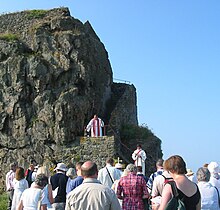Helier
Helier's wanderings led him to the Cotentin where he sought retreat from the distractions of the world in the monastic community of Marculf at Nantus (Nanteuil, now St.-Marcouf-de-l'Isle in Manche).
[2] Helier, however, found the monastic community did not provide the quiet he required to devote himself fully to a life of contemplation.
[3] Though Helier starved himself to ascetic weakness, legend holds that he had the strength, when he was beheaded by attackers, to pick up his head and walk to shore.
According to the hagiography, Romard discovered Helier's body on the beach still clutching his head in his hands, placed it in a boat and set off for the mainland.
The boat, guided by the hand of God, arrived at Bréville-sur-Mer where a reputedly miraculous healing spring arose on the spot where Helier's body rested overnight.
Evidence of veneration of the saint can be found in La Hague in the Cotentin at Querqueville and also at Omonville-la-Rogue where a 13th-century mural in the church of St. John the Baptist links Helier with Thomas Becket.
"[6] Charles Grosset notes that the Passion of St. Helier, written in the 10th or 11th century, draws upon two very much earlier lives of Marculf (A and B), and amends them to suit the narrative.
Grosset's conclusion is that the life of Helier is extremely poorly documented, and like Balleine, he considers it largely fictional.
He discovered a similar sounding name to Helier in the district of Tongres, and also a hermit called Eletus in the Life of St. Marcouf.
He did not hesitate to identify Helier with the near namesake in Tongres, or to make an identification with Eletus, taking the story of a miracle set on an island whose place-name was not to be found on the map."
In Bellows's opinion that Jersey could have so few inhabitants (thirty) at the time compared to Guernsey, in the much better documented visits of Sampson, stretches credulity too far.
The original attribution might have been to Hilary of Poitiers, and became corrupted over time, particularly during the Dark Ages, when the Diocese of Dol was laid waste by invasions of pagans.




